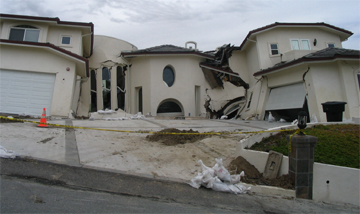 Last January and February,
a number of Southern California residents lost their homes in landslides. As
record amounts of rain fell on the region, hillsides failed and sent million-dollar
homes, swimming pools, cars and lives cascading into the valleys below. Three
homeowners, however, lost their houses to a different type of landslide —
a slow-moving one that is now raising concerns about building regulations and
natural hazards in California and elsewhere.
Last January and February,
a number of Southern California residents lost their homes in landslides. As
record amounts of rain fell on the region, hillsides failed and sent million-dollar
homes, swimming pools, cars and lives cascading into the valleys below. Three
homeowners, however, lost their houses to a different type of landslide —
a slow-moving one that is now raising concerns about building regulations and
natural hazards in California and elsewhere.This multimillion-dollar home in Anaheim, Calif., has cracked over the last several months due to a slow-moving landslide and has since had to be demolished. Questions remain about why exactly this home and others were built on the site in the first place. Courtesy of John Nicoletti, City of Anaheim.
A few years ago, construction began on three multimillion-dollar homes on Ramsgate Drive in the affluent Anaheim Hills neighborhood of Orange County. Two of the homes were finished and inhabited, and one was still under construction. Before this winter’s heavy rains set in, one of the homeowners noticed a crack in the foundation of his house. Over the coming weeks, the homeowners called in city inspectors and consulting geologists, who noticed more cracks and subsequently tested the soil and incline on the hill. After further earth movement following heavy rains, they ultimately determined that the homes were atop a slow-moving landslide and that one of the houses must be demolished to save one of the other two, says John Nicoletti, spokesman for the City of Anaheim.
Unfortunately, Nicoletti says, in the end, it was a futile effort, as one home was demolished and the other two have been “red-tagged”: They are uninhabitable, and demolition is pending. Now, the nature of the hillside — an unstable ancient landslide deposit deep beneath layers of recent fill material — and the civil engineering of the home sites are sparking debate over why these structures cracked and were demolished. And the question of who was responsible, Nicoletti says, will likely lead to litigation.
From the mid-1980s to mid-1990s, the California Geological Survey mapped most of the landslides — from ancient to probable future ones — throughout the state, under a state landslide mapping act, says John Parrish, executive officer of the California State Mining & Geology Board. Since then, under a seismic hazard act, the survey has continued monitoring landslide-prone regions and revising the maps as necessary.
The maps show areas that are susceptible to landslide movement and that “probably are unsafe to build on without specific engineering” designed to counteract nature, Parrish says. Released on April 15, 1998, the Anaheim Hills quadrangle map “showed specifically that the location on Ramsgate Drive that failed was considered highly likely to be subject to landslide movement,” Parrish says. “All three houses were built since that map was released, and all three houses slid. It’s not surprising.”
In California, a seismic hazards disclosure law requires prospective home or land sellers to inform potential buyers if the property is within a seismic hazard zone that includes landslides, says Charles Buckley, an engineering geologist with California Environmental Geologists and Engineers, Inc., in Camarillo, Calif. That disclosure should include whether or not the land is an ancient landslide deposit, as mapped by the California survey, he says, and all of the paperwork should be on file with the city or county.
Before a house is built, homeowners must submit construction plans with a geologic assessment of the land and engineering plan to the city or county planning departments, which should compare the hazard maps to the plans before approving construction, Parrish says. However, Nicoletti says, most cities or counties, including the City of Anaheim, do not have the resources to individually examine each property’s geology, so they have to rely on the owners and the geology consultants to do that. Furthermore, he says, “when a person invests $2.5 million in a piece of dream property, it’s difficult for us to say to someone ‘you can’t build your dream home there’ if their consultant says that they can.”
And that seems to be where the problem lies, Parrish says. “Somewhere along the line, someone dropped the ball,” he says, and “right now, the attorneys for the homeowners whose homes were demolished are busily trying to figure out who that was.” Either “the city should never have approved the plan because the engineering plan for construction wasn’t solid or the geotechnical work was faulty for some unknown reason,” says Stephen Testa, president of Testa Environmental Corporation in Mokelumne Hill, Calif. (and president of the American Geological Institute, which publishes Geotimes). “As of now there is no readily available answer, but you can be assured one will come.”
In the meantime, Testa says, state, county or city agencies in charge of planning need to take more of a leadership role in approving or not approving projects. Indeed, Buckley says, “a regulatory review by the agencies is an important and necessary part of the building process.” Too many projects sneak through that shouldn’t, he says, and if the cities don’t have geologists on staff, “they can farm the work out.”
Still, Buckley says, with the large amount of rain that the region has gotten over the past few months — more than 32 inches since July — this year’s weather situation seems a testament to modern geological engineering. Most of the homes on the hillsides that did fail, he says, were built prior to state ordinances that require landslide mitigation engineering.
Megan Sever

